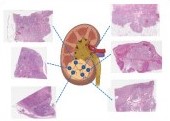Renal cell carcinoma ranks among the top ten most common cancers globally, with the clear cell subtype (ccRCC) accounting for the majority of metastatic cases. While some ccRCC tumors respond to immunotherapy treatment, it is often difficult to predict which patients will benefit. But those who do likely have something else in common—which is why, as with many problems involving pattern recognition, researchers are turning to artificial intelligence (AI) to help them figure out what this “something” is.
At Dana-Farber Cancer Institute, former Damon Runyon Clinical Investigator Eliezer M. Van Allen, MD, and his team have developed an AI-based tool capable of analyzing pictures of tumor samples on pathology slides to answer the question: “What does a tumor that responds to immunotherapy look like?”
Pathologists routinely assess tumor samples on pathology slides to identify key disease features, including nuclear grade, which indicates how much tumor cells deviate from normal cells. The team initially trained their AI tool to do just this, but soon found it capable of doing much more—not only measuring nuclear grade but also detecting variations in grade across tumor samples.
Encouraged, the team expanded their deep learning model to quantify tumor microheterogeneity, which measures the extent to which nuclear grade varies across a sample, and immune infiltration, or how deeply immune cells have penetrated the tumor. Although these measures can be manually determined by pathologists, they are prohibitively time-consuming for routine use.
Then, to explore the predictive potential of these measurements, the researchers applied their tool to pathology slides from ccRCC patients receiving immunotherapy as part of a clinical trial. The tool found that higher levels of tumor microheterogeneity and deeper immune infiltration were associated with better survival.
“These signals are hiding in plain sight,” said Dr. Van Allen. “They are just hard for pathologists to practically measure on individual slides. With AI, we have a scalable way to potentially squeeze a lot more information out of these slides.”
The team next plans to test their tool in an ongoing clinical trial involving combination immunotherapy treatment for ccRCC patients. Eventually, it could be used to guide treatment decision-making.
This research was published in Cell Reports Medicine.







